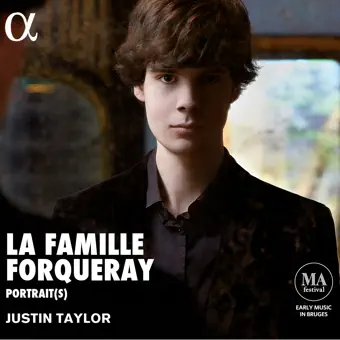november 2016
La famille Forqueray: Portrait(s)
Justin Taylor
Justin Taylor, een jonge klavecinist en recentelijk winnaar van een wedstrijd, laat met deze debuutsolo-cd zien dat hij nu al een gedurfde, eigenzinnige vertolker is. Hij is er zeker een om in de gaten te houden.

De laatste jaren is het gebruikelijk geworden om de Pièces uit 1747 van Forqueray (uitgebracht in twee versies – één voor basgamba, de andere voor klavecimbel) voornamelijk toe te schrijven aan de zoon, Jean-Baptiste, die publiceerde na de dood van zijn vader Antoine. Deze uitstekend bedachte en geproduceerde debuutopname suggereert dat we nog eens goed moeten nadenken.
Zelfs de jonge, Frans-Amerikaanse klavecinist Justin Taylor zelf schrijft de twee suites uit 1747 op deze cd – in ieder geval in hun uiteindelijke vorm – toe aan Jean-Baptiste Forqueray. Toch draagt Taylors eigen gepolijste bewerking van een manuscript van drie delen Suite pour trois violes van ‘Monsieur Forcroy’ (een eerdere spelling die vaak werd gebruikt om naar Antoine te verwijzen) – als het inderdaad van de vader is en niet van de zoon – veel van dezelfde muzikale vingerafdrukken. In de innemende Allemande schuilt een populair liedje. De verleidelijke Courante heeft zo'n uitbundigheid en momentum dat het doet denken aan de grillige Antoine. De pikante harmonische progressies in de poëtische Sarabande voorspellen die in de suites uit 1747. Viol-geleerden beschouwen deze stukken als minder technisch veeleisend dan die uit de collectie uit 1747. Taylor, die de laatste zorgvuldig heeft bestudeerd, heeft er niettemin voor gezorgd dat de eerste een vergelijkbare stijl hebben. Sommigen zouden kunnen zeggen dat hij, net als Jean-Baptiste, het water heeft vertroebeld; anderen zullen vinden dat hij het potentieel van de muziek heeft gerealiseerd.
De cd opent passend met een pretentieloos maar toch volbracht ongemeten Prelude, ook toegeschreven aan Antoine, en volgt dit op met een doordachte, dominante uitvoering van de eerste suite uit 1747. Twee aspecten van zijn interpretatie vallen op: het adembenemende bereik en de subtiliteit van zijn rubato en de onverwachte flarden retorische stilte die hij behendig invoegt. Het laatste deel van de suite, ‘La Couperin’, wordt naast Couperins eigen klavierportret van Antoine geplaatst, hoewel Taylor hier respectvol zijn inégalité inperkt. Duphly’s prachtige eerbetoon aan Jean-Baptiste (en de collectie uit 1747) leidt naar de monumentale Vijfde Suite van de Forquerays, gespeeld met liefde en flair.
Het winnen van de eerste prijs op het Musica Antiqua Festival in Brugge in 2015 stelde Taylor in staat deze opname te maken, die op zichzelf al bestemd is om hem nieuwe lofbetuigingen te bezorgen.

In recent years it has become commonplace to attribute the 1747 Forqueray Pièces (issued in two versions – one for bass viol, the other for harpsichord) mainly to the son, Jean-Baptiste, who published after his father Antoine’s death. This superbly conceived and produced debut recording suggests we should think again.
Even the young, Franco-American harpsichordist Justin Taylor himself attributes the two 1747 suites on this disc– at least in their final form – to Jean-Baptiste Forqueray. Yet Taylor’s own polished arrangement of a manuscript three-movement Suite pour trois violes by ‘Monsieur Forcroy’ (an earlier spelling often used to refer to Antoine) – if it is indeed by the father and not the son – bears many of the same musical fingerprints. Within the ingratiating Allemande lurks a popular song. The seductive Courante has such exuberance and momentum that evokes the mercurial Antoine. The piquant harmonic progressions in the poetic Sarabande presage those found in the 1747 suites. Viol scholars think of these pieces as less technically demanding than those of the 1747 collection. Taylor, having carefully studied the latter, has nevertheless ensured that the former are similarly styled. Some might say that, like Jean-Baptiste, he has muddied the waters; others will feel he has realised the music’s potential.
The disc opens appropriately with an unpretentious but nevertheless accomplished unmeasured Prelude, also attributed to Antoine, then follows it with a thoughtfully commanding performance of the first 1747 suite. Two aspects of his interpretation stand out: the breathtaking range and subtlety of his rubato and the unexpected slivers of rhetorical silence he deftly inserts. The final movement of the suite, ‘La Couperin’, is juxtaposed with Couperin’s own keyboard portrait of Antoine, though here Taylor respectfully curbs his inégalité. Duphly’s exquisite homage to Jean-Baptiste (and the 1747 collection) leads on to the Forquerays’ monumental Fifth Suite, played with affection and panache.
Winning first prize at the 2015 Musica Antiqua Festival in Bruges enabled Taylor to make this recording, which itself is destined to win him fresh accolades.
